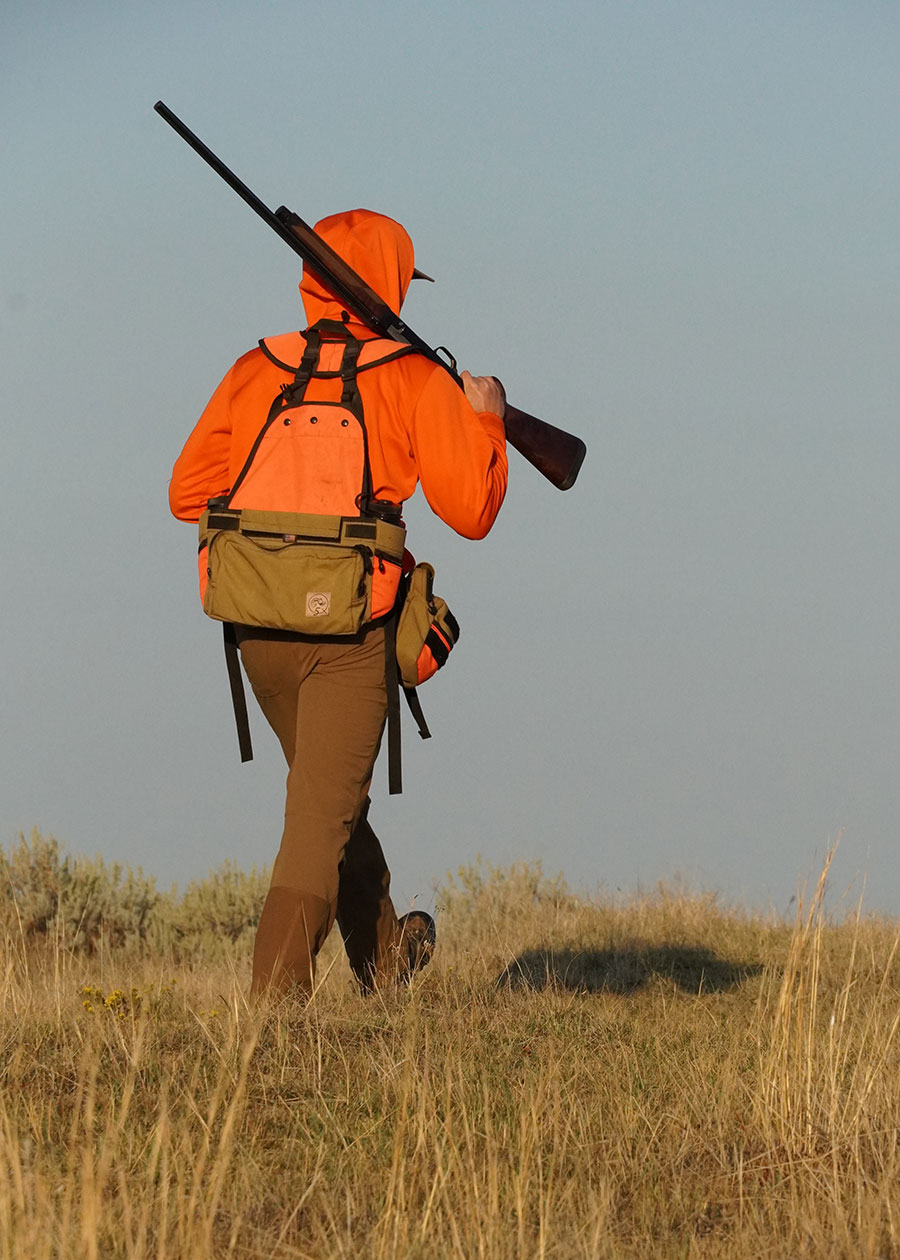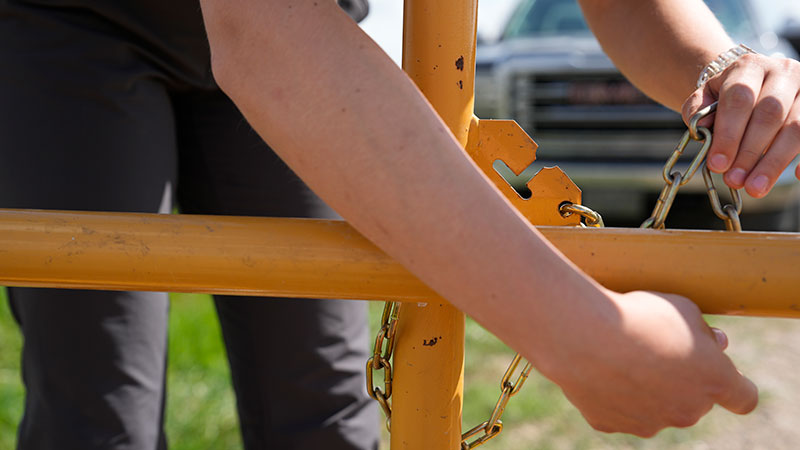The Responsibility of Hunting Safely
Ron Wilson

Most hunting accidents happen because people become complacent, said Brian Schaffer, North Dakota Game and Fish Department hunter education coordinator. With upland game bird seasons in full swing, waterfowl hunters hiding in layout blinds and thousands of hunters heading to the field for North Dakota’s deer gun season, Schaffer offers some tips to combat this complacency, so everyone goes home safely.
NDO: What are some tips deer hunters, upland game bird hunters, waterfowl hunters, all hunters, should employ to be safe in the field this fall?
Schaffer: I think the most important thing for people to remember is it’s your responsibility to be safe in the field. And the most important thing is to just take a moment beforehand, whether it’s with yourself to go over a mental checklist or to have that conversation with the group you’re hunting with, to talk about firearm safety in or around vehicles, in the field, and just general safety and firearm rules you should be aware of before ever loading that firearm and heading out into the field.
NDO: All upland game bird seasons are open and continue through Jan. 1, 2023. What should hunters be aware of when, for example, hunting pheasants in the weeks to come?
Schaffer: Probably the most important thing you need to be aware of is to have that communication with the people you’re hunting with, about maintaining a safe zone of fire for everyone in the party, maintaining a line when you’re walking. And that varies drastically depending on the type of cover you’re in and how fast different people walk. It’s just everyone’s responsibility in a group to make sure you’re maintaining that straight line for safety, which then definitely impacts where your safe zones of fire are.
NDO: Historically, how do most of our hunting accidents occur?
NDO: And keep your safety on until you’re ready to fire.
Schaffer: Absolutely. That safety doesn’t come off until that firearm is shouldered and right before you pull the trigger.

Taking the time to safely cross a fence during deer season
Schaffer: Generally speaking, our accidents occur in or around a vehicle or crossing an obstacle, whether it’s a fence or a creek, especially when we’re in close proximity with other hunters. The big thing to remember when it comes to hunting accidents, the vast majority of them are avoidable. It’s just incredibly important for hunters, especially early in the year when you might be a little bit rusty handling that firearm, it doesn’t matter if you’re taking someone new out or you’re hunting with somebody you’ve been hunting with your entire lifetime. Just take that extra minute to have a little discussion about firearm safety. And don’t be afraid to have that conversation with someone if they’re not being safe. Because it does only take a second or two for something terrible to happen. Most hunting accidents are very avoidable, so we encourage people to have those tough conversations with people.
NDO: Even though it’s not required to wear hunter orange when upland game hunting, the Game and Fish Department certainly recommends it.
Schaffer: We really recommend it for our upland bird hunters so they can be seen by other hunters. This is especially true during the rifle deer season when some of the best pheasant hunting opportunities are at hand. So, we just encourage people to wear that blaze orange even when not required.
NDO: What are some safety tips for waterfowl hunters?
Schaffer: We’ve seen some accidents in recent history with layout blinds. It’s real important to maintain positive muzzle control when in your blind, whether that’s a blind on a wetland or in a layout blind, make sure that muzzle is always pointed in a safe direction, especially when you have hunters or dogs going out to retrieve downed birds. Another thing people don’t really think about, whether they are hunting ducks or trapping near water, is to pack an extra set of clothes in the vehicle, which can be a lifesaver if you do accidentally get wet.
NDO: With more than 64,000 deer gun licenses made available to hunters this year, which will usher a lot of hunters into the field, what are some of the things people should be aware of when going deer hunting?
 Hunters should leave gates teh way they found them
Hunters should leave gates teh way they found themSchaffer: We live in a relatively flat state, so being sure of what your target is and what’s beyond it is vital. Rifle bullets can go a long way on the prairie, so we really recommend people take that extra split second to confirm what they’re shooting at and what’s beyond that target. Also, getting in and out of vehicles is always a tricky situation where we have some accidents occurring and that can be resolved just by taking the extra time to do it the right way. And that’s everybody on the same side of the vehicle unloading firearms completely, leaving those actions open and putting them safely in a vehicle.
NDO: All big game hunters, including bowhunters, are required to wear orange clothing while the regular deer gun season is in progress. Which means a head covering and outer garment above the waistline of solid daylight fluorescent orange color, totaling at least 400 square inches, correct?
Schaffer: Yes. Camouflage blaze orange is not legal, yet we still see that a few times a year where people out in the field are not wearing the legal blaze orange.
NDO: What about hunting off the ground safety?
Schaffer: We see more and more people sitting in tree stands or elevated platforms, and anytime you’re off the ground, we highly recommend using a fall restraint system or a safety strap of some kind. One fall from a tree stand can end in a very serious matter. Any time your feet are off the ground, we want hunters wearing a fall restraint system.
NDO: A lot of our hunting seasons are happening about the same time landowners are in the field harvesting crops, moving cattle, doing what they need to do to make a living. What are some things hunters can do to not interrupt these activities?
Schaffer: The majority of North Dakota is privately owned, and we live in a state that is highly driven by agriculture, whether that’s farming or ranching. And we have a lot of wonderful landowners out there who share their land with hunters and trappers. Understanding that, we really encourage our hunters to take that extra step, to be a good steward and be polite to those landowners. Give them space when they’re out there combining or moving cattle, pull off to the side of the road and let that semi go by without them having to slow down. It’s pretty common for landowners to be harvesting corn and sunflowers during the rifle season.
NDO: And if you come across a gate that’s closed and you open it, make sure you close it when you leave.
Schaffer: Correct. But that goes both ways. If a gate is open, leave it open, because you don’t know if they’re moving cattle from one section of pasture to another. So, leave the gate as you find it and just be courteous at all times and leave it better than when you got there. If you see a pop can on the ground, pick it up. It’s your responsibility as a hunter to do what’s right, even when no one’s watching.
NDO: That goes for empty shotgun shells and rifle casings, correct?
Schaffer: If you’re shooting ducks and geese in a field, you can go through quite a bit of ammunition, especially if you have a group of hunters. We just really encourage you to take that extra 10 minutes to pick up all of those empty hulls.
 Dont leave spent shells in the field
Dont leave spent shells in the fieldNDO: While the Game and Fish often encourages respect for landowners, many of the same courtesies should be shown to other hunters.
Schaffer: Courtesy in the field goes a long way. You don’t know who that other hunter is, and we all kind of have an attitude that we think the spot we’re hunting is our spot. But it may not necessarily be your spot and only your spot. So, give people lots of space. You know, people are pretty protective of where they hunt and the time that they take off from work or the time they spend with family. Knowing that, it’s always best just to side on the side of caution and give that extra space to those other hunters just like you would want them to do to you.
NDO: So, the most important thing this fall is for everybody to have a good time and come home safe.
Schaffer: Absolutely. North Dakota provides some of the best hunting in the nation. And I think there’s lots of room out there for people to get out and enjoy it. Doesn’t matter if you live close to one of our larger urban areas, there are still fantastic hunting opportunities all across the state of North Dakota for people to get out there and enjoy the resources.
NDO: Any closing thoughts for hunters heading outdoors this fall?
Schaffer: Make sure you do your homework. We are very fortunate to live in a state where a lot of our landowners still grant access to hunters. I highly recommend, not the night before you plan on hunting, to get out there and try and make some contacts. Even if you’re going home to where you grew up, reach out to those landowners and have a conversation with them and explain what you’re wanting to do. I can’t emphasize enough about getting out there and knock-on doors and introducing yourself.




